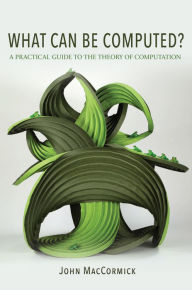What Can Be Computed?: A Practical Guide to the
What Can Be Computed?: A Practical Guide to the Theory of Computation by John MacCormick


- What Can Be Computed?: A Practical Guide to the Theory of Computation
- John MacCormick
- Page: 408
- Format: pdf, ePub, mobi, fb2
- ISBN: 9781400889846
- Publisher: Princeton University Press
Download What Can Be Computed?: A Practical Guide to the Theory of Computation
Read e-books online What Can Be Computed?: A Practical Guide to the Theory of Computation
What Can Be Computed?: A Practical Guide to the Theory of Computation by John MacCormick An accessible and rigorous textbook for introducing undergraduates to computer science theory What Can Be Computed? is a uniquely accessible yet rigorous introduction to the most profound ideas at the heart of computer science. Crafted specifically for undergraduates who are studying the subject for the first time, and requiring minimal prerequisites, the book focuses on the essential fundamentals of computer science theory and features a practical approach that uses real computer programs (Python and Java) and encourages active experimentation. It is also ideal for self-study and reference. The book covers the standard topics in the theory of computation, including Turing machines and finite automata, universal computation, nondeterminism, Turing and Karp reductions, undecidability, time-complexity classes such as P and NP, and NP-completeness, including the Cook-Levin Theorem. But the book also provides a broader view of computer science and its historical development, with discussions of Turing's original 1936 computing machines, the connections between undecidability and Gödel's incompleteness theorem, and Karp's famous set of twenty-one NP-complete problems. Throughout, the book recasts traditional computer science concepts by considering how computer programs are used to solve real problems. Standard theorems are stated and proven with full mathematical rigor, but motivation and understanding are enhanced by considering concrete implementations. The book's examples and other content allow readers to view demonstrations of--and to experiment with—a wide selection of the topics it covers. The result is an ideal text for an introduction to the theory of computation. An accessible and rigorous introduction to the essential fundamentals of computer science theory, written specifically for undergraduates taking introduction to the theory of computation Features a practical, interactive approach using real computer programs (Python in the text, with Java alternatives online) to enhance motivation and understanding Gives equal emphasis to computability and complexity Includes special topics that demonstrate the profound nature of key ideas in the theory of computation Features a companion website that includes additional materials
Understanding Computation - I Programmer
The reason for the practical introduction to Ruby is that in the rest of the book Ruby is used to implement examples of what are often just theoretical constructs. If you are happy to have ideas explained as just theory then you might well object to the amount of Ruby needed to create programs that do something that you
Computer programming - Wikipedia
The purpose of programming is to find a sequence of instructions that will automate performing a specific task or solving a given problem. The process of programming thus often requires expertise in many different subjects, including knowledge of the application domain, specialized algorithms, and formal logic. Related
Theory of computation - Wikipedia
In theoretical computer science and mathematics, the theory of computation is the branch that deals with how efficiently problems can be solved on a model of computation, using an algorithm. The field is divided into three major branches: automata theory and language, computability theory, and computational complexity
A Practical Approach to Morse-Smale Complex Computation
are given at the vertices of a closure-finite and weak topology (CW) complex, therefore enabling computation on a wide variety of meshes such as regular . In our approach, we utilize discrete Morse theory as presented by. Forman [10]. Lewiner . We will use V-paths to compute the MS complex of a discrete gradient field.
The Church-Turing Thesis (Stanford Encyclopedia of Philosophy)
The Church-Turing thesis concerns the concept of an effective or systematic or mechanical method in logic, mathematics and computer science. M will, if carried out without error, produce the desired result in a finite number of steps;; Mcan (in practice or in principle) be carried out by a human being
What Can Be Computed? - What Can Be Computed?
What Can Be Computed? A Practical Guide to the Theory of Computation by John MacCormick. An accessible and rigorous textbook for introducing undergraduates to computer science theory. Princeton University Press.
The Theory and Practice of Navigation and Nautical Astronomy. With - Google Books Result
John Radford YOUNG - 1856
Browse Princeton Catalog in COMPUTERS - Computer Science
Introduction to Computational Science: Modeling and Simulation for the Sciences - Second Edition: Shiflet, A. and Shiflet, G. (Hardcover and eBook) What CanBe Computed?: A Practical Guide to the Theory of Computation: MacCormick, J. ( Hardcover and eBook)
Links: [PDF/Kindle] Broken Nature: Design Takes on Human Survival by Paola Antonelli, Ala Tannir site, [PDF/Kindle] Inappropriate by Vi Keeland read pdf, Read [Pdf]> The Power of Cult Branding: How 9 Magnetic Brands Turned Customers into Loyal Followers (and Yours Can, Too! ) by Matthew W. Ragas, Bolivar J. Bueno download pdf,
0コメント